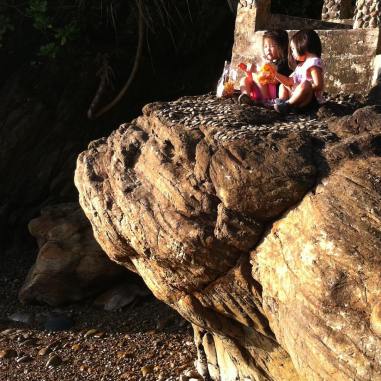The joys of winter break have found us counting – coconuts in trees, monkeys, hermit crabs and more. Many times the numbers come in order: 1, 2, 3, 4, 5 but sometimes explorations take place and values ending with “teen” worm their way in after six or seven. My girls are counting. This happens in French, Chinese and English and they love going through sequences. How many boys? How many girls? How many in our family? With or without the dog?

Taking a break from counting to compare snacks
Recently, I began a great professional development program – the MSIS program that is being hosted at the Shanghai American School. As I wrote, I’m definitely more interested in the happenings at the pre-K level now that my girls are beginning school. In retrospect, it’s also quite valuable to know the progression and expectations of students at different levels leading up to my middle school classroom. So, I’m hoping to also capture some of the math talks and stories that I share with my girls.
XO and I recently had a couple that moved beyond the sequential counting and I’m excited. The first story begins – as many stories from expats – in the back of a taxi. We were on our way to a visit and had to hire a driver as I do not have a Chinese driver’s license. Sitting in the back seats, we faced the pockets behind the front seats. Each pocket had three water bottles it in.
XO began counting, “1-2-3. 1-2-3.”
“How many are there altogether?” I asked.
“1-2-3-4-5-6.”
“OK, do you think there is enough for everyone in the car?”
She then begins pairing up bottles to fingers while assigning each one to a person in the car. “Shu-shu (uncle – we often have the same driver and it’s familiar to call him uncle), mommy, S–(SLM was asleep on the other side of me) and Daddy.”
“What about yourself,” I asked as she often forgets to include herself when counting. Her fingers were already set and she quickly looked down to realize that there were unassigned fingers.
“Yes, and one more.”
“Oh, what will we do with that one.”
“It’s for me too,” she replies. She also rarely forgets herself when it comes to assigning extras. We soon get out without taking any of the water bottles.
——
The story picks up a week later when we were again on a trip with the same driver. As the car rolls away from our house, XO exclaims, “Look, one is gone.”
Honestly, I had no idea what she was talking about. However, she had immediately checked the status of the water bottles. As I scanned the back of the seats, I confirmed that there was now a set of three and a set of two. One was missing. “What do you think happened?”
“I think that shu-shu drank the water.”
“Hmmm, do you think that there is still enough for everyone to have a bottle?”
XO again goes through assigning bottles to people and comes up that there is in fact enough bottles and no extras. She’s pretty excited that there is still one for her even though we again leave without taking any. I was excited to see her making more connections in her thinking. We had the conversation a week earlier regarding the bottles and she carried forward the number of bottles to the next week and then made a comparison to the current value. Evaluating the difference she made the realistic step forward that the driver had drank one.
Story 2 – Greater than, equal to, or Less than
Having a meter stick around the house is a great prop for stories. I wouldn’t recommend it stay out too long at any one time or the more creative uses of a stick will come to one of the two girls, but bringing it out for a task and then leaving it hanging around can offer some great opportunities. As soon as I was finished measuring whatever it was that I needed a value on, XO grabbed the stick. She began moving around the living room and holding it up to things. I soon began asking if the items were greater than, equal to or less than the stick. She scurried around and propped the stick against the item in question.
The chair – greater than
The dog – less than
Her sister – less than
Then, I began asking her to find things that were greater than…
the dresser, the door, the wall
or less than
her shoes, a doll
equal to was challenging and she didn’t find anything exactly matching.
It was a fun experience of her making comparisons and evaluating the size of items.
